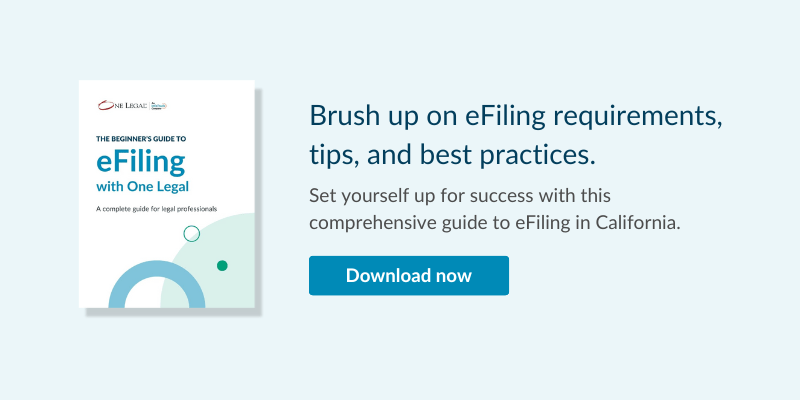California court rules define eService as “service of a document, on a party or other person, by electronic transmission or electronic notification.” Pretty straightforward: the other parties receive digital documents rather than physical ones.
Most states and counties that have implemented electronic court filing for legal documents, like Illinois, Indiana, and Texas, also have rules in place that permit or encourage electronic service of those documents.
There are a few different ways this can work.
- Electronic transmission – Email the documents to each party
- Electronic notification – Store the documents on a secure platform and send links to participatory parties to view
How eService works
Step 1: File your documents with One Legal
Upload your legal documents and file them in your chosen court via the One Legal platform.
In eFiling courts, parties automatically opt in to electronic service notifications when they electronically file documents. And if eFiling is mandatory, eService is also mandatory. If your court still only accepts physical documents, other parties will have to agree to accept eService. Learn more about how to eServe when physically filing documents.
Step 2: Confirm eService list
At the end of your transaction, you’ll be asked if you would like to serve your documents. Include parties named on your documents and add any other involved parties to compile a list of your recipients.
Step 3: eServe documents
Once you select “Serve,” every person on the list will receive an electronic message from One Legal notifying them that you have eServed them documents. To view the files, recipients simply click on the secure link in the email and are taken directly to the saved documents.
Traceability
The only thing you can trace after sending an email is the fact that you did, indeed, send the email. Whether it ended up buried in the recipient’s spam folder or ignored in the flurry of the day, you’ll never really know. And you certainly won’t be able to find out if the attached document itself was ever opened and read.
An eService provider like One Legal, however, can provide you with a list of recipients along with the status of who opened the email, who clicked on the link, and who viewed the documents, and when. It’s confirmation that everyone has been properly served the important legal documents.
Verifiable proof of service
A ‘Sent’ email won’t cut it when it comes to verifying proof of service any more than it will help with tracing the receipt of documents. For documents that will require a proof of service, eService through an electronic service provider is the most effective way to eServe.
Learn more about how to easily create a verifiable proof of service for your eServed documents.
Security
All documents that are filed with One Legal are stored securely in your Case Portfolio, easily accessible for you and viewable to anyone who has been sent the secure link.
Convenience
When you use a certified electronic service provider like One Legal, you can do more than launch an email into the void. You can easily add a traceable, secure eService directly after filing legal documents through the One Legal platform.
Attaching lengthy documents to an email can be tricky, too, and often requires compressing or otherwise altering the document so that it will travel. Rather than going through that hassle and waiting for the extra time it takes to send, you can conduct eService from within the filing portal.
Organization of discovery
Discovery documents are much better managed through true eService. We’ve found that many people don’t realize One Legal facilitates stand-alone eService for documents that don’t need to be filed.
Discovery docs can be large and cumbersome, and hard to track using more traditional methods. Using a service like One Legal can make it more manageable.
It’s important to note that eService does not replace personal service of initiating documents, which most jurisdictions still require to be done by hand (or in some cases by mail). eService is primarily used for subsequent filings, as notification of eFiled documents to other parties.
eService is available throughout states where eFiling has taken effect, such as California, Illinois, Indiana, and Texas.
***
Have questions about eService? Stop by our weekly office hours, hosted by rock star trainers, Lili and Brooke, to learn more about the benefits of eService.






